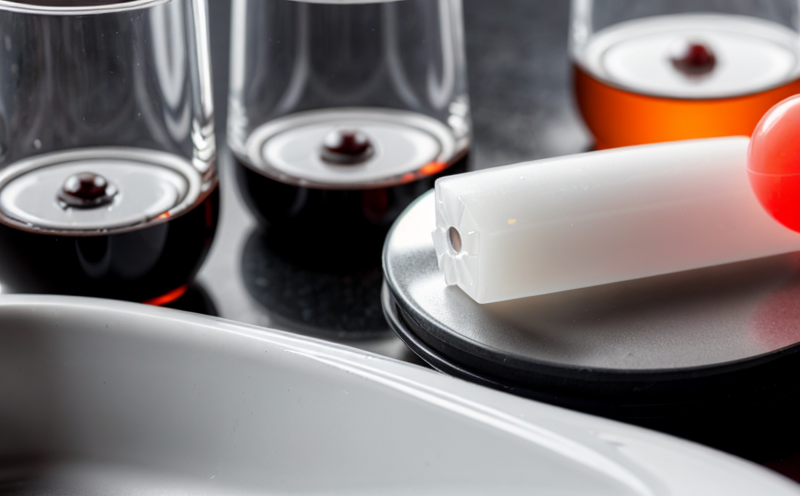JIS R1620 Nanoparticle Size Measurement in Fine Ceramics
The JIS R1620 standard is a cornerstone of quality assurance and compliance within the fine ceramics industry. This method specifically addresses the critical need for accurate nanoparticle size measurement, which is essential for ensuring product consistency and performance across various applications. Fine ceramics are widely used in electronics, aerospace, automotive, and medical sectors due to their exceptional mechanical properties, high thermal stability, and chemical resistance.
The primary focus of JIS R1620 lies in the precise determination of particle size distribution, which is crucial for optimizing manufacturing processes and ensuring product quality. Particle size plays a significant role in dictating the performance characteristics of fine ceramics, such as hardness, density, and thermal expansion coefficient. By adhering to this standard, manufacturers can ensure that their products meet the stringent requirements set by international standards.
The testing method outlined in JIS R1620 employs dynamic light scattering (DLS) technology, which is known for its accuracy and reproducibility in measuring particle sizes ranging from 0.5 nm to several micrometers. This technique involves suspending nanoparticles in a solvent and observing the scattered laser light to derive size distribution parameters. The precision of this method ensures that even minute differences in particle size can be detected, which is critical for fine ceramics where uniformity is paramount.
Preparation of samples before testing is an essential step in ensuring accurate results. This typically involves dispersing the nanoparticles into a suitable solvent to prevent agglomeration and ensure a homogeneous suspension. The choice of solvent is crucial as it can influence both the stability and dispersion state of the particles, thereby affecting the measured size distribution.
Once prepared, samples are analyzed using an instrument equipped with DLS technology. The process involves calibrating the instrument to known standards before testing the sample. This step ensures that all measurements are accurate and reproducible. After calibration, the sample is introduced into the measuring chamber, where it is exposed to a laser beam. The scattered light patterns are captured by a detector, which then processes this data to generate a particle size distribution profile.
The results of JIS R1620 testing provide valuable insights for quality managers and compliance officers responsible for ensuring product consistency. By adhering to these standards, manufacturers can identify any deviations from the expected particle size distribution, allowing for timely adjustments in production processes. This not only enhances product quality but also ensures that products meet regulatory requirements and customer specifications.
For R&D engineers, JIS R1620 offers a robust framework for optimizing nanoparticle formulations. By understanding the relationship between particle size and performance characteristics, these engineers can develop more efficient and effective materials tailored to specific applications. Furthermore, this standard provides a consistent basis for comparing different batches or suppliers of fine ceramics, facilitating quality control across the supply chain.
In summary, JIS R1620 is an indispensable tool in the fine ceramics industry, providing precise particle size measurement that supports quality assurance and compliance. Its application ensures that products meet stringent international standards, enhancing reliability and performance across various sectors.
Eurolab Advantages
- Comprehensive Expertise: Eurolab boasts a team of experts with extensive experience in nanomaterials testing. Our personnel are well-versed in the intricacies of JIS R1620 and other relevant standards, ensuring accurate and reliable results.
- Innovative Technology: We utilize cutting-edge DLS instruments that offer high precision and accuracy, delivering consistent results every time.
- Robust Quality Assurance: Our laboratories are equipped with state-of-the-art facilities that adhere to international standards. This ensures that all tests meet the highest quality benchmarks.
- Comprehensive Reporting: Eurolab provides detailed reports that include not only particle size distribution but also other relevant parameters, offering a holistic view of sample characteristics.
Our commitment to excellence and our deep understanding of JIS R1620 and related standards ensure that clients receive accurate, reliable, and actionable data. This supports informed decision-making and process optimization in the fine ceramics industry.
Environmental and Sustainability Contributions
The measurement of nanoparticle size distribution using JIS R1620 plays a vital role in promoting sustainability within the fine ceramics sector. By ensuring consistent product quality, this standard helps reduce waste and energy consumption throughout the manufacturing process. Accurate particle size measurement enables manufacturers to optimize production processes, leading to more efficient resource utilization.
In addition, adherence to JIS R1620 contributes to environmental compliance by ensuring that products meet stringent international standards. This reduces the risk of non-compliance penalties and enhances corporate reputation. Furthermore, by providing reliable data for quality assurance, this standard supports the development of greener materials and processes, fostering a more sustainable industry.
The precise measurement of particle size distribution also facilitates the development of new materials with improved properties, potentially leading to innovations that reduce environmental impact. For instance, optimized nanoparticle formulations can enhance the performance of fine ceramics in energy-efficient applications, contributing to broader sustainability goals.
Competitive Advantage and Market Impact
- Innovation Leadership: Eurolab’s proficiency in JIS R1620 and related standards positions us as leaders in nanomaterials testing. This expertise enables us to provide clients with cutting-edge insights and solutions.
- Enhanced Reputation: By consistently delivering accurate and reliable results, we enhance our clients’ reputations within the industry. This is particularly important for maintaining competitive advantage in a market-driven environment.
- Cost Efficiency: Accurate particle size measurement reduces rework and waste, leading to cost savings throughout the supply chain. This efficiency enhances profitability and competitiveness.
- Broad Customer Base: Our comprehensive testing services cater to a diverse range of industries, from electronics to aerospace. This broad reach helps us maintain strong relationships with our clients and expand market presence.
By leveraging JIS R1620 and other relevant standards, Eurolab contributes significantly to the competitiveness and sustainability of its clients’ operations. Our services are instrumental in driving innovation, ensuring compliance, and enhancing overall performance within the fine ceramics industry.





